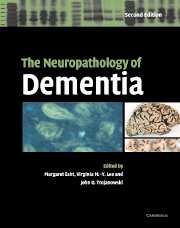Book contents
- Frontmatter
- Contents
- List of contributors
- List of abbreviations
- Preface to second edition
- 1 Definition, clinical features and neuroanatomical basis of dementia
- 2 Important anatomical landmarks in the brain in dementia
- 3 Practical approach to pathological diagnosis
- 4 Morphometric methods and dementia
- 5 Safety precautions in laboratories involved with dementia diagnosis and research
- 6 Molecular diagnosis of dementia
- 7 Neuropathology of the ageing brain
- 8 Neuroimaging Alzheimer's disease
- 9 Alzheimer's disease
- 10 Down's syndrome and Alzheimer's disease
- 11 Sporadic tauopathies: Pick's disease, corticobasal degeneration, progressive supranuclear palsy and argyrophilic grain disease
- 12 Hereditary tauopathies and idiopathic frontotemporal dementias
- 13 Vascular dementias
- 14 Familial and sporadic cerebral amyloid angiopathies associated with dementia and the BRI dementias
- 15 Parkinson's disease, dementia with Lewy bodies, multiple system atrophy and the spectrum of diseases with α-synuclein inclusions
- 16 Huntington's disease
- 17 Human prion diseases
- 18 Alcoholism and dementia
- 19 Hydrocephalus and dementia
- 20 Head injury and dementia
- 21 Infectious (and inflammatory) diseases causing dementia
- 22 Schizophrenia and its dementia
- 23 Other diseases that cause dementia
- 24 Transgenic mouse models of neurodegenerative disease
- Appendix: Dementia brain banks
- Index
1 - Definition, clinical features and neuroanatomical basis of dementia
Published online by Cambridge University Press: 12 October 2009
- Frontmatter
- Contents
- List of contributors
- List of abbreviations
- Preface to second edition
- 1 Definition, clinical features and neuroanatomical basis of dementia
- 2 Important anatomical landmarks in the brain in dementia
- 3 Practical approach to pathological diagnosis
- 4 Morphometric methods and dementia
- 5 Safety precautions in laboratories involved with dementia diagnosis and research
- 6 Molecular diagnosis of dementia
- 7 Neuropathology of the ageing brain
- 8 Neuroimaging Alzheimer's disease
- 9 Alzheimer's disease
- 10 Down's syndrome and Alzheimer's disease
- 11 Sporadic tauopathies: Pick's disease, corticobasal degeneration, progressive supranuclear palsy and argyrophilic grain disease
- 12 Hereditary tauopathies and idiopathic frontotemporal dementias
- 13 Vascular dementias
- 14 Familial and sporadic cerebral amyloid angiopathies associated with dementia and the BRI dementias
- 15 Parkinson's disease, dementia with Lewy bodies, multiple system atrophy and the spectrum of diseases with α-synuclein inclusions
- 16 Huntington's disease
- 17 Human prion diseases
- 18 Alcoholism and dementia
- 19 Hydrocephalus and dementia
- 20 Head injury and dementia
- 21 Infectious (and inflammatory) diseases causing dementia
- 22 Schizophrenia and its dementia
- 23 Other diseases that cause dementia
- 24 Transgenic mouse models of neurodegenerative disease
- Appendix: Dementia brain banks
- Index
Summary
Introduction
Dementia is a frequent consequence of neurodegenerative diseases involving the cerebral cortex. Unlike stroke, encephalitis or head injury, which lead to relatively circumscribed and stable brain damage, degenerative disorders often affect many regions of the brain. The widespread changes in brain structure and the multiple signs of cognitive impairment that result from such changes have led to a conceptualization of the degenerative dementias, and especially of Alzheimer's disease, as ‘diffuse’ pathological processes, but this is not strictly true. The degenerative dementias, including Alzheimer's disease, do not affect the entire cerebral cortex equally. Instead, the degenerative dementias are associated with varied profiles of anatomic involvement, which can be tracked by quantitative histopathological and neuroimaging techniques. Association and limbic regions suffer the brunt of the damage.
It is widely accepted that cognition is supported by distributed neural systems, and that it is susceptible to dissociation by focal brain damage. Despite continued uncertainties about the physiology underlying normal cognition, locally and globally, the pathological functional anatomy of many cognitive disorders is beginning to be elucidated. Classic examples of such disorders and their anatomic correlates include anterograde declarative amnesia, which is due to lesions of the hippocampal formation and adjacent mesial temporal lobe structures; aphasia, which is due to lesions in the left perisylvian cerebral cortex; ideomotor apraxia, which is due to lesions of the left parietal lobe; and simultanagnosia, which is due to bilateral lesions of the dorsal occipital and parietal lobes. The clinical manifestations of degenerative processes clearly depend in part on which neural structures and systems are affected earliest and most extensively. It is now apparent that degenerative dementia can present with impairments resembling any of the classic ‘focal’ disorders listed above.
- Type
- Chapter
- Information
- The Neuropathology of Dementia , pp. 1 - 33Publisher: Cambridge University PressPrint publication year: 2004
- 4
- Cited by

